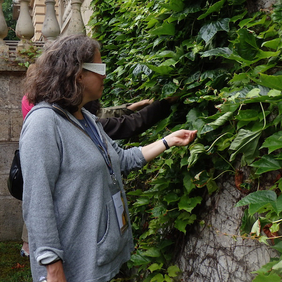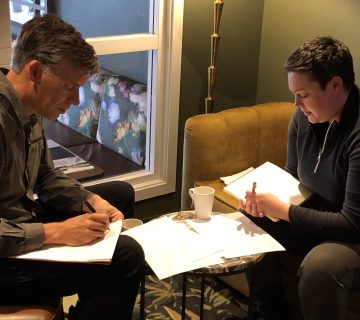A participant’s experience on the first CIG course to be held in Poland, which has had a long-reaching and somewhat mystical impact.
It’s Monday 18th June and I take my every-day route through the park to work. As I walk down the pathway, I can still notice the colourful outlines of the countries, that Valya and Thorsten asked us to draw on the first day of the CIG course. I take a look to the right and see Ania interpreting the stand-alone lime tree. The scent of lime flowers gets mixed up in my head with the memory of Dragana singing during our farewell evening. I decide to cross the bridge and picture Jelena telling the stories about three ladies of the Villa Decius. As I pass the Villa I realise that after hearing Mateusz’s interpretation I won’t look at it the same way again. I instinctively want to enter the building, but the sound of silence and no friendly soul wandering with the morning coffee on the balcony tell me that today, for the first time in a week, I won’t find any exercise papers left by Alicja’s considerate hand. Instead, I turn left and just as I get the glimpse of the woody crocodile hidden in the grass, I can suddenly feel all the adrenaline and excitement that accompanied me through my final interpretative talk. I start to think that the park, now filled with phenomena we discovered throughout the course, will never be just a plain park to me again. Breathe in, breathe out. OK, it’s time to get to work!
Tuesday 19th June. Everyone at MIK (the Małopolska Institute of Culture) keeps asking us about our impressions of the CIG course. Together with Sebastian, my fellow coursemate, we start to exchange a million thoughts, inspirations and questions that have arisen in our heads throughout and since the course. Our eyes start to spark as we share the ideas for our take-home interpretative walk and tell how we are going to put the newly acquired knowledge and experience into practice (both of us deal professionally with heritage in theory rather than practice). The others look at us with an understanding smile, and I can almost read their thoughts: ‘Yeah, they’re a lost cause.’
Friday 29th June. I pass the Ethnographical Museum on my way home and start recalling our group working together, discussing different topics, themes and phenomena, and finally coming up with one coherent interpretive walk. I still remember the second when it struck me: How common it is for a bunch of wonderfully various people, each of them equipped with their own set of knowledge, experience and ideas, to work together like a well-oiled machine? The other mind-blowing moment came not long after. I listened to Carla from Azores interpreting the hand-made folk toy from the times of the Peasant Revolt in Galicia (Poland), and then Manoles from Spain revealing the symbolic meaning of Polish Christmas ornaments and I thought how much we truly have in common. It all started to come together: the theory, the tools, the experience, the people.
What does it take to find the hidden phenomena? 40 hours of well-designed training? The passionate trainer-assistant team? Inspiring people that happen to meet in the right place and the right time? Or maybe this perfect moment when you start revealing the meaning? It’s now Wednesday 4th July and I still can’t tell. All I know is that the search itself is the most fun in the world!
Małgorzata Rapacz is a graduate of ethnology and cultural anthropology from the University of Warsaw. She currently works for MIK where she supports the team of Małopolska Days of Cultural Heritage. She can be contacted at: rapacz@mik.krakow.pl
To cite this article:
Rapacz, Małgorzata (2018) ‘In search of the hidden phenomena’. In Interpret Europe Newsletter 2-2018, 23.
Available online:
www.interpret-europe.net/fileadmin/Documents/publications/Newsletters/ie-newsletter_2018-2_summer.pdf




